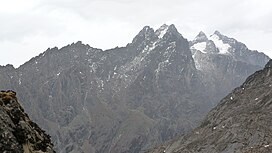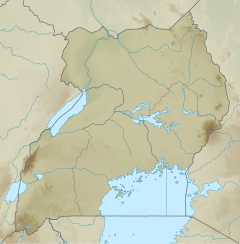Mount Stanley or Mount Ngaliema (/əŋɡɑːˈljeɪmə/,[2] also US: /-mɑː/,[3] UK: /əŋˌɡɑːliˈeɪmə/[4]) is a mountain located in the Rwenzori range. With an elevation of 5,109 m (16,763 ft), it is the highest mountain of both the Democratic Republic of the Congo and Uganda, and the third highest in Africa, after Kilimanjaro (5,895 m) and Mount Kenya (5,199 m). The peak and several other surrounding peaks are high enough to support glaciers. Mount Stanley is named for the journalist and explorer Sir Henry Morton Stanley. It is part of the Rwenzori Mountains National Park, a UNESCO World Heritage Site.[5]
| Mount Stanley | |
|---|---|
| Mount Ngaliema | |
 Mount Stanley from left to right: Moebius Peak, Elena Peak, Savoia Peak, Alexandra Peak, Margherita Peak | |
| Highest point | |
| Elevation | 5,109 m (16,762 ft) |
| Prominence | 3,924 m (12,874 ft)[1] Ranked 28th |
| Listing | Country high point Ultra Ribu |
| Coordinates | 0°23′09″N 29°52′18″E / 0.38583°N 29.87167°E |
| Geography | |
| Countries | |
| Parent range | Rwenzori Mountains |
| Climbing | |
| First ascent | 1906 by Duke of the Abruzzi and party |
| Easiest route | rock/snow climb |
Mt. Stanley consists of two twin summits and several lower peaks:
Peak metres feet Margherita Peak 5,109 16,763 Alexandra 5,091 16,703 Albert 5,087 16,690 Savoia 4,977 16,330 Ellena 4,968 16,300 Elizabeth 4,929 16,170 Phillip 4,920 16,140 Moebius 4,916 16,130 Cheptegei 4,907 16,099 Great Tooth 4,603 15,100
Expeditions
edit- First ascent
The first recorded ascent of Mt. Stanley was in 1906 by Luigi Amedeo, J. Petigax, C. Ollier, and J. Brocherel. Margherita Peak is named after Queen Margherita of Italy.[6]
References
edit- ^ "World Ribus – East Africa Mountains". World Ribus. Retrieved 2024-12-26.
- ^ "Ngaliema". Collins English Dictionary. HarperCollins. Retrieved 2 August 2019.
- ^ "Stanley, Mount". Merriam-Webster.com Dictionary. Merriam-Webster.
- ^ "Ngaliema, Mount". Lexico UK English Dictionary. Oxford University Press. Archived from the original on 2022-08-26.
- ^ "Rwenzori Mountains National Park". UNESCO World Heritage Centre. Retrieved 11 February 2024.
- ^ Bridges, Peter (Winter 2000). "A Prince of Climbers". Virginia Quarterly Review. Vol. 76, no. 1. pp. 38–51. Retrieved 11 February 2024.
External links
edit- Media related to Ruwenzori Range at Wikimedia Commons
- "Information about Mount Stanley and the Ruwenzori Range". skimountaineer.com.
- "Mount Stanley". Peakbagger.com.
- "Mount Stanley". SummitPost.org.
- "Mount Stanley". Peakware.com. Archived from the original on 2016-03-04.
